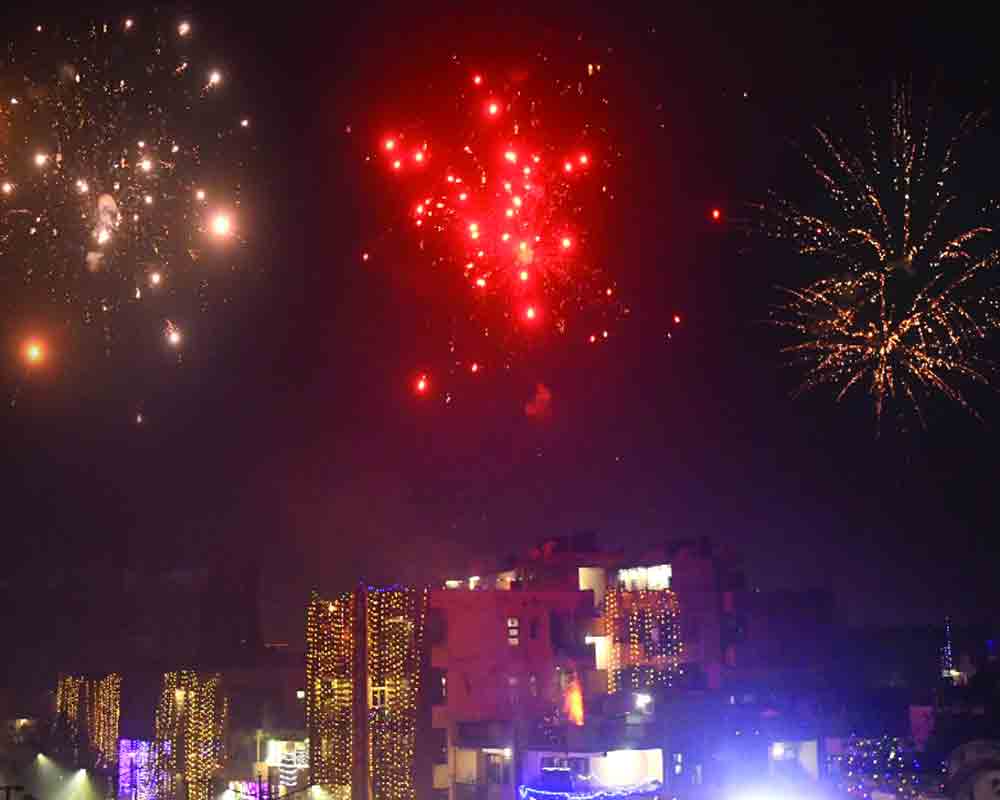In flagrant disregard of the Supreme Court order, the residents of Delhi and its neighbouring areas defied the ban and were openly seen bursting firecrackers on the night of Diwali amid deteriorating air quality. This caused PM10 and PM2.5 levels to soar in several parts of the city on Sunday night, resulting in heavy pollution across the entire city.
Delhi recorded its best air quality on Diwali day in eight years on Sunday, with the 24-hour average Air Quality Index (AQI) settling at 218 at 4 pm. The AQI stood at 275 (in the poor category) at 7 am on Monday and gradually rose to 358 by 4 pm. However, the bursting of firecrackers until late Sunday night led to a spike in pollution levels amid low temperatures.
Senior citizens, patients, children, and individuals with breathing ailments had to stay indoors, but the noise from crackers was a concern not only for them but also for animals, particularly pets and domestic animals. Every noise from the crackers in the surrounding areas unnerved the pets, making them scream for a safe shelter indoors.
However, legal experts said the judiciary cannot enforce the Supreme Court’s orders on the ban of firecrackers and stubble burning to curb air pollution, as it can be addressed only by creating mass awareness.
The Supreme Court’s recent order, which banned the manufacture and sale of firecrackers containing barium, was violated across the country on Diwali, leading to a worsening air quality index.
Senior advocate Gopal Sankaranarayanan, representing the main petitioner Arjun Gopal and others seeking a ban on the sale and manufacture of firecrackers, has decided to move a contempt petition in the top court against law enforcement agencies for the flagrant violation of the court’s recent order.
Speaking on the violation of judicial orders, senior advocate Rakesh Dwivedi expressed the view that no contempt proceedings will be effective in cases like these, where there are many contributors to the rise in air pollution.
“These are social issues. The contempt action seems to be very difficult. How many people, and whom they (the Supreme Court) will catch? Basically, this is the issue of social awareness. People should be made more aware. I don’t find much of a role for courts and lawyers,” he said.
Dwivedi further mentioned that there are so many culprits like manufacturers, sellers, retailers, buyers, and those who are bursting firecrackers, and advocated for a year-round awareness campaign.
Advocate and environmentalist Gaurav Kumar Bansal, actively pursuing such cases at various judicial forums, also agreed with Dwivedi. He stated that a social awareness campaign is needed to achieve desired results, emphasising that the Supreme Court orders alone cannot curb the rising menace.
Dwivedi highlighted that a multi-pronged strategy is needed to address air pollution because the bursting of firecrackers is not the only contributor.
According to IQAir, a Swiss company specialising in air quality monitoring, Delhi was the most polluted city in the world on Monday, followed by Lahore and Karachi in Pakistan. Mumbai and Kolkata ranked fifth and sixth among the most polluted cities globally.
Social media visuals showed people gathering in the parks of the locality to burst crackers. Many others questioned the Supreme Court ban and the failure of the authorities in implementing it. Insiders say many shopkeepers stored firecrackers a month ago, while the Supreme Court stated that its order banning firecrackers containing barium applies to every State and is not limited to Delhi and NCR on November 7.
In the India Gate area in the heart of the city, the AQI level stood at 999. According to aqicn.org, in the Major Dhyan Chand National Stadium area as well, the AQI stood at 999 in the morning and later came down to 553. The index was recorded at 970 in Pusa, and in the Anand Vihar area, it stood at 849. Most real-time air monitoring platforms this morning pegged the air quality index (AQI) above 500, with some places reaching as high as 999.
Jawaharlal Nehru Stadium recorded an AQI of 910, Lajpat Nagar 959, and Karol Bagh 779 around 6 am.
Firecracker bursting pushed the PM2.5 concentration at many places, including Okhla and Jahangirpuri, in the capital to over 1,000 micrograms per cubic metre in the early morning hours.
An AQI level of 400-500 impacts healthy people and is dangerous to those with existing diseases, while a level of 150-200 brings discomfort to people with asthma, lung, and heart problems. Levels of 0-50 are considered good.
The ruling AAP Government has alleged that individuals associated with the BJP instigated residents to burn firecrackers on Diwali, leading to an overnight increase of over 100 points in the national Capital’s air quality index. Delhi Environment Minister Gopal Rai claimed that the police of these States permitted the transportation of firecrackers to Delhi. He also blamed the BJP governments in the States for being behind it.
Terming the Arvind Kejriwal Government as visionless, Delhi BJP president Virendra Sachdeva shared details, saying on November 4, the AQI of Anand Vihar was 498 and questioned whether crackers were being burnt then, whereas after the Diwali festival, the AQI was around 250. The BJP further stated that the Kejriwal Government has not deployed any team to ensure the ban. “No team was found on the ground,” the Leader of Opposition Ramvir Singh Bidhuri said.
Meanwhile, BJP leader Kapil Mishra on Monday said he is “proud of Delhi” for bursting crackers on Diwali, terming the move as “voices of freedom and democracy.”
The city recorded its best air quality on Diwali day in eight years on Sunday, with its 24-hour average Air Quality Index (AQI) settling at 218 at 4 pm. However, firecrackers bursting till late Sunday night led to a spike in pollution levels amid low temperatures.


























